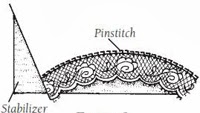1. Pin the lace to the right side of the fabric with the heading even with the seam allowance line and the right side of the lace facing up. Using a small zigzag (L=1.0; W=1.5) and a 70 Universal needle, stitch the heading to the fabric (fig. 1).
 |
| Fig. 1 |
2. If the lace is being attached to a curved edge, shape the lace around the curve referring to the lace shaping directions. If necessary, pull the uppermost thread in the lace heading to make the lace lie flat (fig. 2a).
 |
| Fig. 2a |
For inside curves, shape the lace into a curve on the ironing board before placing it on the fabric. This will keep the scalloped edge from being wavy (fig. 2b).
 |
| Fig. 2b |
3. Press the seam allowance away from the lace, toward the wrong side of the fabric (fig. 3).
 |
| Fig. 3 |
If the edge is curved or pointed, you may need to clip the seam allowance in order to press flat (fig. 4).
 |
| Fig. 4 |
4. On the right side, use a short, narrow zigzag to stitch over the lace heading, catching the fold of the pressed seam allowance (fig. 5) or follow step 7 below.
 |
| Fig. 5 |
5. On the wrong side, trim the seam allowance close to the stitching (fig. 6).
 |
| Fig. 6 |
6. If the design includes miters, stitch them with a small zigzag (fig. 7).
 |
| Fig. 7 |
7. Optional:
a. Place a lightweight tear-away stabilizer to the wrong side of the lace shaping area. Change to a 110 or 120 Universal needle.
b. From right side of fabric, pin stitch the lace to the fabric along the heading of the lace (L= 2.5 - 3.0; W= 2.0 - 2.5) (fig. 8). Carefully remove the stabilizer.
 |
| Fig. 8 |
If you'd like to learn more lace techniques, be sure to check out our DVD Normandy Lace with Martha Pullen. Normandy lace refers to the patchwork quilt of lace. It usually consists of a central motif with beautiful pieces of lace, embroidery and overall lace forming the body of the piece.
On the DVD, Martha will show you the tricks of machine embroidery on netting, along with what stabilizers and thread to use. You will also learn how to create lace-shaped diamonds, hearts, curves and more.
Sew On, Sew Well, Sew Beautiful,
Cyndi and Amelia

Thank you! Great tutorial!
ReplyDeleteWonderful tip! I've learned something new today. Thanks!
ReplyDeleteWonderful!
ReplyDelete